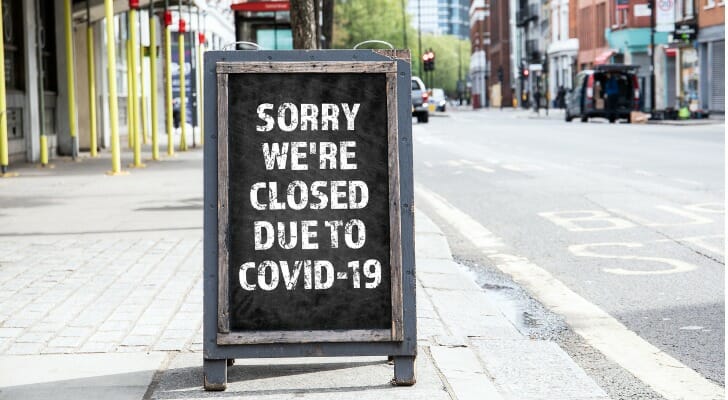Paycheck Protection Program (PPP) loans were the main small-business provision of the CARES Act, intended to prop up small businesses with forgivable loans. These loans were discontinued in May of 2021 but those who received the loans can still apply for forgiveness today. The loans could have been for 2.5 times payroll costs, up to $10 million and required no collateral. Since this program is no longer operational, you may want to research other business relief options if you’re looking for funds for your business. If you’re feeling overwhelmed, now may be a good time to consult a financial advisor.
Who Qualified for a PPP Loan?
While the PPP loan program ended in 2021, let’s take a look at who could have qualified and how the program worked.
Any small business with 500 or fewer employees might have been eligible for relief. This includes small businesses, S corporations, C corporations, LLCs, private nonprofits, faith-based organizations, tribal groups and veteran groups. Self-employed individuals who file an IRS Schedule C with their Form 1040, such as independent contractors and sole proprietors, are also eligible. (Partners who report self-employment income, however, are not eligible as self-employed individuals.)
Restaurants and hospitality businesses may have qualified if they had 500 or fewer employees per location. Details on the size standards and exceptions are on the SBA website.
Ineligible businesses included those engaged in illegal activities, owners more than 60 days delinquent on child support obligations, farms and ranches, sex businesses, lobbyists and gambling establishments.
Also, in response to the outcry over public companies receiving PPP loans when most mom-and-pops, who really need the government help, didn’t, the Treasury has ruled that hedge funds, private equity firms and most public companies with substantial market values were ineligible for PPP loans. Also, the program was closed to companies that were involved in bankruptcy proceedings.
Terms of PPP Loans Given During the Pandemic
The government’s efforts to help businesses have resulted in generous terms for PPP loans during 2020 and 2021. Borrowers could have received two and a half times their average monthly payroll costs (excluding compensation in excess of $100,000 per employee) incurred 12 months before the date the loan is made (some lenders are simply using 2019 numbers).
For example, if your monthly average payroll (excluding compensation in excess of $100,000 salaries) in the prior 12 months was $10,000, you may borrow up to $25,000. Additionally, you could include as payroll costs: payment for vacation, parental, family, medical and sick leave (that is not covered by another emergency loan/grant); payment for dismissal or separation; payment for group health care coverage, including insurance premiums; payment for retirement benefits and payment of state and local taxes assessed on employees’ compensation.
The maximum any business could borrow is $10 million. This calculator gives a snapshot of what you could have borrowed:
The money could be used for payroll (no more than $100,000 annual salary per employee, which comes out to $46,154 per individual over a covered period of 24 weeks or $15,385 per individual over a covered period of eight weeks), benefits (including paid sick leave and insurance premiums) and taxes on compensation. Up to 40% of the loan may be used to cover mortgage interest, rent and utilities (the ceiling was 25% before the new bill, the PPPFA, became law).
The PPPFA also expanded the number of time borrowers had to spend their loans and have them forgiven. Before, covered expenses had to be incurred over the eight weeks right after loan disbursement. Now, small business owners may opt for the 24 weeks after the disbursement of their loan. Also, they have until December 31, 2020 (instead of June 30) to rehire or restaff up to their pre-pandemic level.
Any portion of the loan that is not forgiven carries an interest rate of 1.0% and is due to be paid back within five years of the loan origination. (Loans made before June 5, 2020, had a two-year term, as they were disbursed before the PPPFA was enacted.) Payments may be deferred for the first six months. There was no pre-payment penalty.
When and How to Apply for a PPP Loan
The PPP loan program ended on May 31, 2021. However, those who received funds may still be eligible for PPP loan forgiveness if they meet the qualifications below. No other applications are being taken at this time.
PPP Loan Forgiveness
Borrowers can have their loans forgiven if they used the money for designated expenses, and many can still get forgiveness today. Participants are eligible for loan forgiveness for the amounts spent on authorized expenses over 24 weeks after loan disbursement (or eight weeks if they choose).
Total payments for payroll may be forgivable. Mortgage interest, rent and utilities are also forgivable, up to 40% of the PPP loan. (Note that if your loan is forgiven, theses expenses covered by the loan are not tax-deductible, as the IRS recently stated in Notice 2020-32.)
To get the entire amount of the loan forgiven (assuming that at least 60% is spent on payroll and the rest on permitted expenses), you must meet two criteria.
1. Full-time Employee Headcount Cannot Decline: The full-time employee headcount could not have declined from average monthly levels during 2019 or during the 12-month period prior to receiving the loan. If your business launched in the second half of 2019, you can use average head counts from January 1, 2020, to February 29, 2020. If your business is seasonal, you can base your monthly averages on numbers from February 15, 2019, or March 1, 2019, to June 30, 2019.
Employers who already let workers go prior to that date were given until December 31, 2020, to restaff. Exceptions for maintaining head counts will be made if you can’t rehire the people you let go and you cannot find qualified replacements. Exceptions will also be made if you cannot return to your pre-pandemic level of business activity due to social distancing and other coronavirus-related restrictions.
2. Employers Could Not Cut Salaries or Wages: Second, for loans to become full grants, employers cannot cut salaries or wages. If they did, the forgiven amount will be reduced.
You must fill out the SBA’s application for PPP loan forgiveness in order to get the process started.
PPP Loan Fraud
Many larger corporations and individuals received loans and forgiveness through the PPP loan program during the pandemic that many believed to be wrongly awarded. In August of 2022, President Biden signed a pair of bills that give the government more time to investigate and prosecute any wrongdoing related to fraud in the PPP loan program.
The Bank Fraud Enforcement Act and the COVID-19 EIDL Fraud Statue of Limitations Act have established a 10-year statute of limitations for the government to investigate any potential criminal charges or civil enforcement related to the PPP loans. The EIDL was another program that offered similar support as the PPP loan program.
Many believe that wrongful payments and forgiveness were awarded to businesses that shouldn’t have qualified, which the government blames on the fast payments needed during the pandemic. It is estimated that up to 70,000 PPP loans that total more than $4.6 billion could have been fraudulent loans given out by the government through the PPP loan program alone.
Bottom Line
The Payroll Protection Program provided a total $659 billion to small businesses and independent contractors to maintain payrolls and head counts during the COVID-19 crisis. The lending program used a streamlined, low-documentation process and does not require collateral.
If qualifying employers generally don’t lay off employees or cut wages, the loans can be forgiven, effectively making them full or partial grants, depending on how borrowers put the proceeds to use. The PPP loan program is one of many government programs to help small businesses. And private initiatives, such as Facebook grants, are also available. Businesses that received the loans can still apply for forgiveness in 2022.
Tips for Business Owners During the Coronavirus Crisis
- Some financial advisors specialize in working with business owners. Finding a financial advisor doesn’t have to be hard. SmartAsset’s free tool matches you with up to three vetted financial advisors who serve your area, and you can interview your advisor matches at no cost to decide which one is right for you. If you’re ready to find an advisor who can help you achieve your financial goals, get started now.
- In addition to the new PPP loan, the SBA also has other loan programs to help small businesses, including Economic Injury Disaster Loans (EIDLs).
Photo credit: ©iStock.com/MicroStockHub, ©iStock.com/tumsasedgars, ©iStock.com/ela bracho


